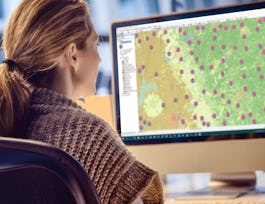The "Geospatial Technology for Construction" course adopts a multi-disciplinary approach, integrating key aspects of Geospatial and Construction Engineering. The content is structured into seven modules for a comprehensive learning experience. In Module One, learners will understand geospatial thinking, its daily applications, and the importance of spatial thinking. This includes differentiating information types and communicating spatial information effectively. Module Two explores the necessity of Geospatial Technology in the construction industry, covering its role in tender processes, design, execution, and lifecycle management. Module Three delves into geospatial surveying and mapping, introducing components, basics of surveying, and advanced solutions through practical use cases. Module Four covers digital level, electronic total station, and GNSS technologies, demonstrating their use and providing an overview of GNSS components and field procedures. Module Five introduces advanced spatial sensing and imaging technologies, including scanning, remote sensing, and sensor applications. Module Six provides in-depth knowledge of photogrammetry and LiDAR, with practical demonstrations of equipment and data processing. Module Seven explores engineering solutions in geospatial contexts, introducing CORS, scan-to-model techniques, and construction site optimization using UAVs. Visualization in construction projects is also emphasized. We look forward to you joining us on this journey into Geospatial Technology for Construction, equipping you with essential skills and knowledge for this dynamic field!



Geospatial Technology for Construction
This course is part of Geospatial Techniques for Engineers Specialization

Instructor: Subject Matter Expert
Sponsored by Syrian Youth Assembly
Recommended experience
What you'll learn
Learn fundamental geospatial concepts and their application in construction, from spatial data communication to practical case studies.
Explore surveying methods, equipment like GNSS and electronic total stations, and practical uses in mapping and data processing.
Understand remote sensing, photogrammetry, LiDAR, and UAVs, with a focus on data collection, imaging, and geospatial engineering solutions.
Details to know

Add to your LinkedIn profile
7 assignments
September 2024
See how employees at top companies are mastering in-demand skills

Build your subject-matter expertise
- Learn new concepts from industry experts
- Gain a foundational understanding of a subject or tool
- Develop job-relevant skills with hands-on projects
- Earn a shareable career certificate


Earn a career certificate
Add this credential to your LinkedIn profile, resume, or CV
Share it on social media and in your performance review

There are 7 modules in this course
This module provides an introduction to geospatial thinking and its applications in everyday life. Learners will explore the importance of spatial thinking, differentiate between information and location information, and understand the necessity of communicating spatial information in spatial formats. The module also covers the logic and language specific to geospatial technologies, distinguishing GIS from associated 6systems.
What's included
10 videos3 readings1 assignment1 discussion prompt
This module focuses on the role of geospatial technology in the construction industry. Learners will explore the location perspective of construction activities across different phases, from analysis and tendering to design, execution, and operations & maintenance (O&M). The module emphasizes the integration of geospatial technologies throughout the construction lifecycle management.
What's included
9 videos1 assignment1 discussion prompt
This module delves into the fundamentals of geospatial surveying and mapping. Learners will gain insights into the components of geospatial technologies, basic surveying principles, types of surveys, traversing concepts, and the necessity for advanced geospatial solutions. The module also includes a use case discussion to illustrate practical applications of these technologies.
What's included
8 videos1 assignment1 discussion prompt
This module provides essential knowledge of surveying technologies, focusing on digital level, electronic total station, and GNSS (Global Navigation Satellite System). Learners will explore the equipment used in geospatial surveying, including demonstrations of leveling and total station devices. The module also covers GNSS navigation essentials, including an overview of GNSS components, signal structure, sources of errors, and various processing methods. Additionally, learners will discover the applications and advantages of GNSS in different contexts.
What's included
14 videos1 assignment1 discussion prompt
This module introduces advanced concepts in spatial sensing and imaging technologies. Learners will explore 3D scanning, various sensory systems, and the science behind sensors. The module covers platform solutions and their applications in remote sensing, providing insights into how these technologies are used in practical scenarios.
What's included
10 videos1 assignment1 discussion prompt
This module delves into imaging and sensing technologies such as photogrammetry and LiDAR (Light Detection and Ranging). Learners will explore the principles and applications of photogrammetry and LiDAR, including demonstrations of terrestrial LiDAR equipment for outdoor and indoor scanning. The module also covers advanced sensing applications including bathymetry and ground-penetrating RADAR, highlighting their data collection and processing methodologies.
What's included
13 videos1 assignment1 discussion prompt
This module focuses on engineering solutions in geospatial contexts, emphasizing applications such as CORS (Continuously Operating Reference Station) and scan-to-model technologies. Learners will explore the optimization of construction sites using UAVs (Unmanned Aerial Vehicles) and techniques for quantity estimation and visualization.
What's included
9 videos1 assignment1 discussion prompt
Instructor

Offered by
Why people choose Coursera for their career




Recommended if you're interested in Physical Science and Engineering

L&T EduTech

L&T EduTech

L&T EduTech

University of California, Davis

Open new doors with Coursera Plus
Unlimited access to 10,000+ world-class courses, hands-on projects, and job-ready certificate programs - all included in your subscription
Advance your career with an online degree
Earn a degree from world-class universities - 100% online
Join over 3,400 global companies that choose Coursera for Business
Upskill your employees to excel in the digital economy


